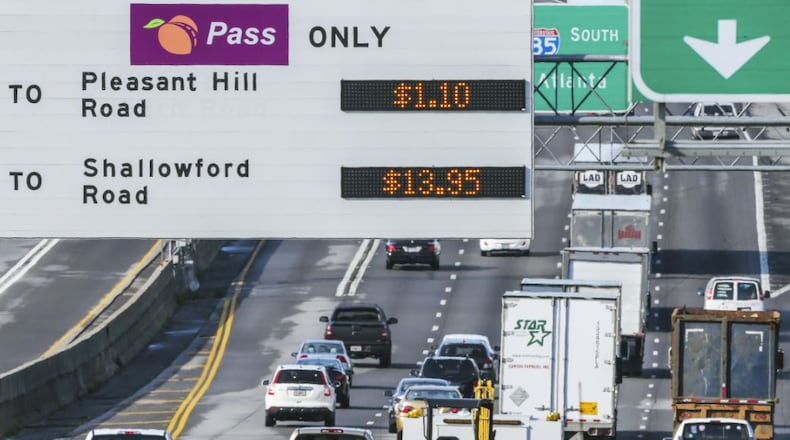State transportation officials have eliminated toll limits on Georgia express lanes – a move that could raise the cost to use the I-85 lanes beginning next week.
Earlier this month, the State Road and Tollway Authority repealed restrictions on toll charges, previously set at a maximum of $13.95 to drive the I-85 lanes in DeKalb and Gwinnett counties. It also repealed the 90-cent-per-mile maximum on the I-75 South Metro Express Lanes in Clayton and Henry counties.
The decision is part of a move to standardize toll rates across all express lanes. It’s not expected to have an immediate impact on I-75, but could affect I-85 commuters when the new policy takes effect Monday.
VIDEO: More on Georgia’s express lanes
SRTA Executive Director Chris Tomlinson said the cost to drive the full 16-mile length of the I-85 could reach $15 to $16 at times. But he said most drivers won’t pay that much because they don’t drive the full length of the lanes. The agency expects the average toll on the lanes to be $5.50 to $6.50.
“People shouldn’t be alarmed by this,” Tomlinson said.
But removing the toll cap could some anger commuters.
“Who gets to make these decisions without the input of the taxpayers that are footing the bill?” said McDonough resident John Alton.
The change in tolls comes as Georgia prepares to open 30 new miles of express lanes on I-75 and I-575 in Cobb and Cherokee counties. They're part of a planned 120-network of express lanes that will eventually include the northern half of the Perimeter and Ga. 400.
The express lanes are a big part of the state's plans to address metro Atlanta's traffic mess. Motorists who use those lanes ideally will be able to travel at least 45 mph – if they're willing to pay a toll.
To deliver on that pledge, SRTA raises the toll as traffic gets worse. The idea is to raise it high enough to discourage some people from using the express lanes, which keeps traffic moving.
About 9,000 vehicles travel the 12-mile I-75 express lanes each weekday. But the toll has not reached the maximum of 90 cents per mile since they opened in January 2017.
By contrast, about 30,000 vehicles use the I-85 lanes, and the toll reaches the maximum of $13.95 on most weekdays. The lanes are often congested at rush hour, and SRTA has a tough time keeping traffic moving at 45 mph.
Tomlinson said eliminating the cap will allow the agency to raise the toll high enough to keep I-85 express lane traffic moving.
The I-85 lanes sparked a public outcry when they opened in 2011, in part because the state converted existing high-occupancy vehicle lanes to toll lanes. Many residents said the state was essentially taking away free lanes of traffic, then charging to use them. Some also complained it was traffic relief for the rich, and dismissed them as “Lexus lanes.”
The Georgia Department of Transportation learned from that experience – all the express lanes its building or planning now will be new lanes, not converted lanes.
Some motorists aren’t upset about the prospect of paying higher tolls. Atlanta resident John Elliot uses the I-85 lanes on weekend getaways to North Carolina. He said it’s a good way to avoid traffic congestion.
“If the traffic keeps moving, the price increase will not bother me,” Elliot said.
Eliminating the maximum tolls is just one way SRTA is standardizing rates. It’s also setting a minimum toll of 10 cents a mile on all lanes. Currently, the cost is 1 cent per mile on the I-85 lanes.
SRTA is also replacing the per-mile toll with a flat fee from 12 a.m. to 5 a.m., when demand is low. The fee would be 50 cents per trip, regardless of how many miles a motorist drives in the express lanes.
Tomlinson said different toll rates for the different highways developed over time in response to specific circumstances. But he said uniform rates make sense as Georgia continues to expand its express lane system.
He said uniform rates would create a “consistent customer experience on Georgia express lanes.”
Express lane tolls
Beginning Monday, there will be uniform toll rates on all Georgia express lanes:
- Minimum 10 cents a mile for most of the day
- No maximum toll
- 50-cent fee per trip from 12 a.m. to 5 a.m.
About the Author
Keep Reading
The Latest
Featured






